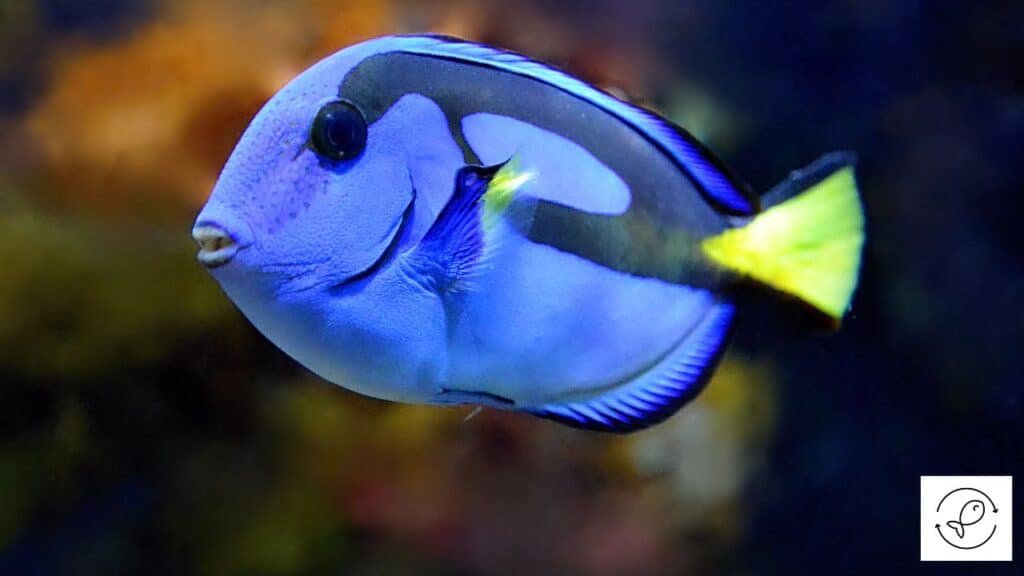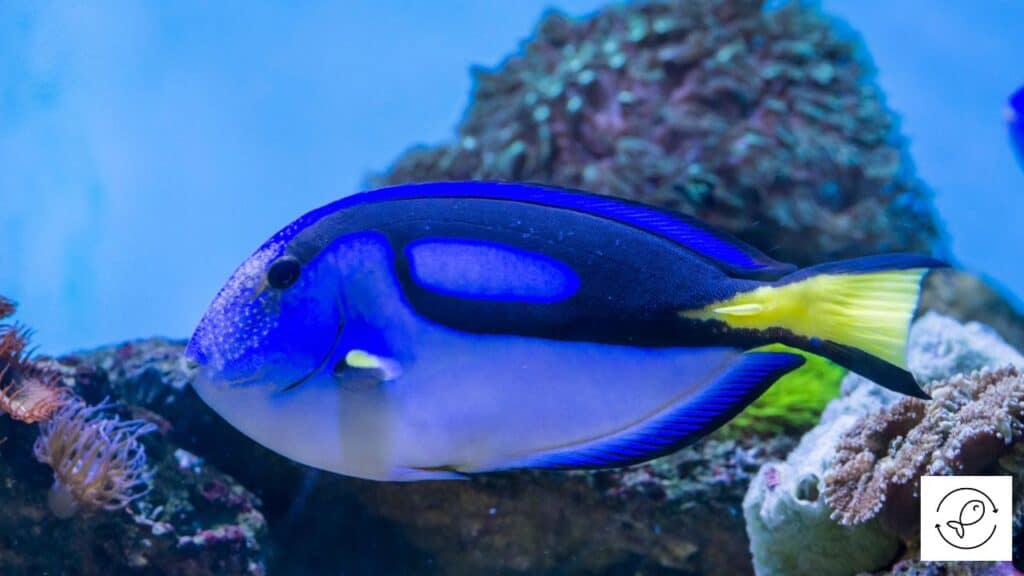Blue tangs primarily feed on algae and planktons in their natural habitat. In captivity, you can feed them algae-based food such as spirulina, algae wafers, algae tablets, nori, packaged food such as flakes and pellets, green veggies, and live or frozen food such as brine shrimp, bloodworms, etc.
Let’s dig a bit deeper into this.
Ideal Diet for Blue Tangs
Blue tangs are grazing fish. Hence, it’s vital that they have a good supply of food throughout the day.
A diverse and balanced food is essential to keep blue tangs healthy and happy.
Given below are some food items that you can feed blue tangs in your aquarium.
Algae-Based Food
Algae are the primary food source of blue tangs. The majority of a blue tang’s diet should consist of algae and algae derivatives.
Blue tangs eat all types of foods related to microalgae. They constantly graze on algae on the coral reefs.
Hence, they must get a lot of grazing opportunities in an aquarium.
For that, you can include live rocks in the aquarium so that blue tangs can graze on algae in between meal times.
Algae wafers, tablets, nori, and spirulina are different algae foods that are good for blue tangs.
Spirulina is an excellent source of protein for blue tangs.
It contains high levels of essential amino acids, vitamins, and minerals that are necessary for the optimum growth of blue tangs.
Similarly, nori is rich in nutrients and minerals.
You can use a seaweed holder or place the nori underneath a piece of coral or rock to feed the blue tangs.
You can also use nori sheets cut into strips and placed at the bottom of the tank.
Packaged Food
Packaged food is another good alternative to feed blue tangs. These food items are readily available and cheap.
You can feed high-quality algae flakes and pellets to your blue tangs.
These foods have high nutritional value and contain essential vitamins and minerals that your fish need.
Moreover, numerous marine packaged food is available at pet stores, and you can choose the one that suits your fish.
The best thing about these foods is that they’re easy to feed, and any leftover food can be easily cleaned from the tank.
Meaty Food
Algae is the most preferred food of blue tangs. However, they also happily gobble any meaty food offered to them.
You can feed live or frozen food such as brine shrimp, blood worms, mysis shrimp, krill, chopped squid, etc.
Live food is an excellent source of protein for blue tangs.
Similarly, frozen food is a great option because it’s safe and easy to handle.
However, ensure the frozen food is thawed before giving it to your fish. You shouldn’t put frozen food directly into the tank.
Instead, place it inside a container with some water so that it defrosts gradually.
You should also avoid feeding blue tangs too much live food because it can cause bloating and other digestive issues.
You can feed live or frozen food twice a week to meet the dietary requirements of blue tangs.
Veggies
Veggies are an important part of a blue tang’s diet as they provide essential vitamins and minerals that help keep your fish healthy.
You can feed fresh vegetables like blanched lettuce, spinach leaves, kale, broccoli, etc., twice a week to your blue tangs.
Marine seaweed is also a good source of nutrition for blue tangs.
Feeding a varied diet to blue tangs is best to get all the essential nutrients from different foods for optimal growth.
What Do Blue Tangs Eat in The Wild?
Blue tangs primarily feed on filamentous algae in the wild. In addition, they also eat tiny aquatic creatures known as plankton.
Adult blue tangs are omnivores that feed primarily on benthic or bottom-dwelling algae and occasionally eat plankton.
Young blue tangs, on the other hand, eat lots of phytoplankton.
They use their sharp teeth to scrape off algae from the coral reef.
Adult blue tangs sometimes forage for food singly or in pairs, while smaller ones form large groups and swim long distances browsing for algae throughout the reef.
Blue tangs avoid eating corals and other calcareous material as they don’t have a gizzard-like stomach that can help them grind the hard food items.
Blue tangs are important for the reefs ecosystem as they help keep algae under control, thus preventing algae from overgrowing on corals and suffocating them.
How Often Should You Feed Blue Tangs?

Blue tangs have a fast metabolism. So you need to feed them thrice a day.
They frequently graze on algae and other plant matter in their natural habitat.
Hence, a constant food supply in home aquariums is essential for their healthy development.
You can add live rocks to the tank. They not only act as decoration but also provide an additional food source for your fish.
The advisable quantity of food to feed blue tangs is the one that they can finish in around 3 to 5 minutes.
Any leftover food should be immediately removed from the tank to avoid contamination of the tank water.
Also, avoid overfeeding your blue tangs as this can lead to digestive problems or other health-related issues.
How Long Can Blue Tangs Survive without Food?
Blue tangs can survive 4 to 5 days without food. It’s because they’re frequent algae grazers.
They can survive on only algae in the tank without any supplemental food.
Occasionally skipping a meal doesn’t do much harm to them.
However, keeping blue tangs without adequate food for a long duration isn’t advisable.
The absence of food can cause stress and weaken their immune system.
Blue tangs can lose their appetite if they don’t find food around them.
This can result in sickness and prove fatal if left unattended. Starvation for a prolonged duration can be fatal to your fish.
What Do Powder Blue Tangs Eat?
Powder blue tangs are an excellent addition to a tank as they spruce it up with their beautiful color.
However, they need adequate care for optimal growth.
Primarily herbivores, these fish feed on benthic algae, green macroalgae, and tiny algae growths within the crevices of the reef rock.
You should provide powder blue tangs with a steady supply of suitable food in the tank as they’re continuous feeders in their natural environment.
It’s best to replicate their natural feeding habits as closely as possible.
Feeling a balanced and nutritious diet can help you meet their dietary requirements.
Given below is the best diet for powder blue tangs in a home aquarium:
- Flake foods that are algae-based as these tangs primarily feed on algae in the wild.
- Algae supplements like spirulina or dried seaweed.
- Live or frozen foods like brine shrimp, mysis shrimp, krill, etc. that are rich in proteins. Live foods help them grow faster and also provide them with essential nutrients.
- Live rocks can be added to the aquarium for better algae growth. Powder blue tangs love to nibble on the algae that grow on these rocks.
- Garlic supplements are also healthy as they help your fish fight off Ich disease.
What Do Atlantic Blue Tangs Eat?
Atlantic blue tangs are surgeonfish found in the Caribbean Sea and the Atlantic Ocean.
They primarily feed on benthic algae such as green algae, brown algae, blue-green, red-green, and sometimes seagrass.
Atlantic blue tangs are energetic and frequent grazers that need to be fed more than some other marine fish.
In captivity, you can feed them a varied diet consisting of high-quality vegetable-based food.
Being herbivores, the ideal diet of these fish includes algae-based foods, flakes, vegetable pellets, spirulina, etc.
You can place dried macroalgae, such as nori sheets, in an aquarium with a few pieces of live coral or rock work.
This will provide them with enough food.
Vegetables like broccoli, spinach, zucchini, leaf lettuce, kale, etc., are also healthy food.
These vegetables contain essential nutrients necessary for the fish’s growth.
You can also occasionally supplement their diet with live or frozen bloodworms, brine shrimp, mysis, and krill as a treat once or twice a week.
Feeding protein-rich food helps stimulate their growth and meet their protein requirements.

